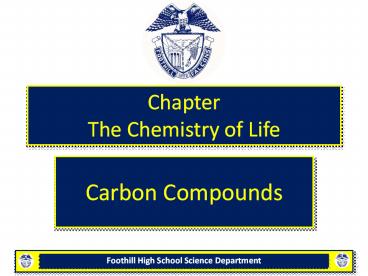Chapter The Chemistry of Life - PowerPoint PPT Presentation
1 / 30
Title: Chapter The Chemistry of Life
1
ChapterThe Chemistry of Life
- Carbon Compounds
2
The Chemistry of Carbon
- Carbon
- 4 Valence Electrons
- Bonds with
- Hydrogen, Oxygen,
- Phosphorus, Sulfur,
- Nitrogen
- Other Carbon Atoms
3
The Chemistry of Carbon
- Methane Single
Bonds - Acetylene Triple Bonds
4
The Chemistry of Carbon
- Butadiene Double
Bonds - Benzene Ring
Bonding
5
The Chemistry of Carbon
- Covalent Bonds of Carbon
- May Be Single, Double, or Triple
- But Always a Total of Four (4) Bonds
- No Other Element is so versatile.
- Millions of Different Structures
6
Macromolecules
- Means Giant Molecules
- Each Macromolecule Is Constructed of Thousands to
Hundreds of Thousands of Smaller Molecules Called
Monomers.
monomer monomer monomer. Macromolecule
7
Macromolecules
- Monomers Are The Basic Building Block (Smallest
Unit) of Any Macromolecule - Monomers Combine And Become Polymers Through
Polymerization
Monomer Macromolecule(Polymer)
Glucose Starch Cellulose
Nucleotides DNA RNA
Amino Acids Proteins
8
Groups of Macromolecules
- Carbohydrates
- Lipids
- Nucleic Acids
- Proteins
9
Carbohydrates Sugars
- CHO in ratio of 121
- Main source of energy for life
- Cellulose Structural Polymer in Plants
- Starches Storage Polymer in Plants
- Fats Storage Polymer in Animals
- Mono Polysaccharides
10
Carbohydrates
- Key Concept
- Living Things Use Carbohydrates As Their Main
Source of Energy! - Plants and some Animals Use Carbohydrates For
Structural Purposes - e.g. Cellulose
11
Carbohydrates - Monosaccharides
- Single Sugars
- Glucose (Universal)
- Galactose (Milk)
- Fructose (Fruits)
12
Carbohydrates - Polysaccharides
- Polysaccharides
- Glycogen (Animals)
Poly means Many
Saccharide means Sugar
13
Carbohydrates - Polysaccharides
- Polysaccharides
- Starch (Plants)
- Cellulose (Plants)
14
Carbohydrates - Disaccharides
- Sucrose
- Maltose
- Lactose
15
Lipids (fats)
- Key Concept
- Lipids Can Be Used To Store Energy.
- Lipids Are Important Parts Of Biological
Membranes And Waterproof Coverings
16
Lipids (fats)
- Made Mostly of Carbon Hydrogen
- Not Water Soluble
- Categories of Lipids Include
- Fats
- Oils
- Waxes
- Steroids
17
Lipids (fats)
- Saturated Fats
- Each Carbon Atom In The Fatty Acid Chain Is
Joined To Another Carbon By A Single Bond - That Means The Macromolecule Contains The Maximum
Number of Hydrogens - Solid At Room Temperature
- Butter, Margarine, Lard, Shortening, etc.
18
Lipids (saturated fat)
- Formed from Glycerol Fatty Acids
19
Lipids (fats)
- Unsaturated Fats
- One Or More Carbon to Carbon Bond(s) Is/Are
Multiply Bonded - These Lipids Are Liquid At Room Temperature
- Olive Oil, Peanut Oil, Other Cooking Oils
20
Lipids (unsaturated fat)
21
Nucleic Acids
- Macromolecules with C, H, O, N P
- Monomer Nucleotide
- Polymers Nucleic Acids
- 5 Carbon Sugar
- Phosphate Group
- Nitrogen Base
22
5 Carbon Sugars
- RNA
- Ribonucleic Acid
- DNA
- Deoxyribonucleic Acid
23
5 Carbon Sugars
- DNA RNA
Deoxyribose Sugar
Ribose Sugar
The Only Difference
24
Nucleic Acids
- Key Concept
- Nucleic Acids Store Transmit Hereditary or
Genetic Information - Every Life Form Uses The Same Nucleic Acids
25
Proteins
- Macromolecules with C, H, O, N
- Monomer Amino Acid
- Polymer Protein
- Compounds with an Amino Group (NH2) and a
Carboxyl Group (-COOH) on the other end - This Allows bonding between any amino acid
- 20 AAs in nature
26
Amino Acid R Groups
- Each Amino Acid Is Different in the -Group
27
Amino Acid R Groups
- Some Polar, some Non-Polar
- Some Acidic, some Basic
- Some contain Carbon Rings
Amino Acid
28
Proteins
- Key Concept
- Proteins Control the rate of reactions
- Proteins Regulate Cellular Processes
- Proteins Form Bones Muscles
- Proteins Transport Substances In/Out of Cells
- Proteins Fight disease
29
Levels of Organization
- Sequence of Amino Acids
- Amino Acid Twists Folds Within Chain
- Twists Folds of Chain Itself
- Multiple Protein Chains May Be Necessary To Make
An Active Protein
Protein Shape Is Critical To Function
30
Hemoglobin

